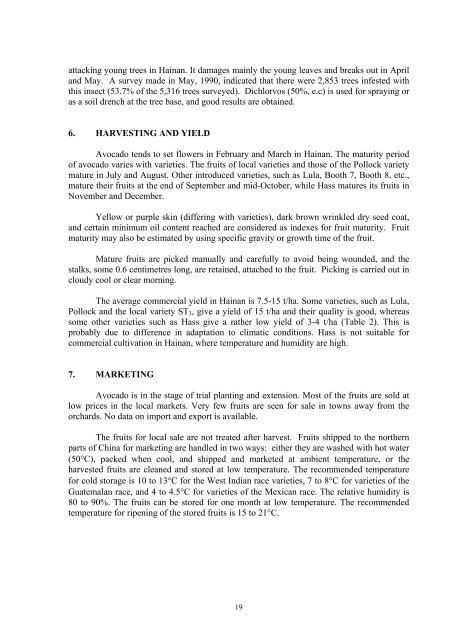Avocado Production in Asia and the Pacific - United Nations in ...
Avocado Production in Asia and the Pacific - United Nations in ...
Avocado Production in Asia and the Pacific - United Nations in ...
You also want an ePaper? Increase the reach of your titles
YUMPU automatically turns print PDFs into web optimized ePapers that Google loves.
attack<strong>in</strong>g young trees <strong>in</strong> Ha<strong>in</strong>an. It damages ma<strong>in</strong>ly <strong>the</strong> young leaves <strong>and</strong> breaks out <strong>in</strong> April<br />
<strong>and</strong> May. A survey made <strong>in</strong> May, 1990, <strong>in</strong>dicated that <strong>the</strong>re were 2,853 trees <strong>in</strong>fested with<br />
this <strong>in</strong>sect (53.7% of <strong>the</strong> 5,316 trees surveyed). Dichlorvos (50%, e.c) is used for spray<strong>in</strong>g or<br />
as a soil drench at <strong>the</strong> tree base, <strong>and</strong> good results are obta<strong>in</strong>ed.<br />
6. HARVESTING AND YIELD<br />
<strong>Avocado</strong> tends to set flowers <strong>in</strong> February <strong>and</strong> March <strong>in</strong> Ha<strong>in</strong>an. The maturity period<br />
of avocado varies with varieties. The fruits of local varieties <strong>and</strong> those of <strong>the</strong> Pollock variety<br />
mature <strong>in</strong> July <strong>and</strong> August. O<strong>the</strong>r <strong>in</strong>troduced varieties, such as Lula, Booth 7, Booth 8, etc.,<br />
mature <strong>the</strong>ir fruits at <strong>the</strong> end of September <strong>and</strong> mid-October, while Hass matures its fruits <strong>in</strong><br />
November <strong>and</strong> December.<br />
Yellow or purple sk<strong>in</strong> (differ<strong>in</strong>g with varieties), dark brown wr<strong>in</strong>kled dry seed coat,<br />
<strong>and</strong> certa<strong>in</strong> m<strong>in</strong>imum oil content reached are considered as <strong>in</strong>dexes for fruit maturity. Fruit<br />
maturity may also be estimated by us<strong>in</strong>g specific gravity or growth time of <strong>the</strong> fruit.<br />
Mature fruits are picked manually <strong>and</strong> carefully to avoid be<strong>in</strong>g wounded, <strong>and</strong> <strong>the</strong><br />
stalks, some 0.6 centimetres long, are reta<strong>in</strong>ed, attached to <strong>the</strong> fruit. Pick<strong>in</strong>g is carried out <strong>in</strong><br />
cloudy cool or clear morn<strong>in</strong>g.<br />
The average commercial yield <strong>in</strong> Ha<strong>in</strong>an is 7.5-15 t/ha. Some varieties, such as Lula,<br />
Pollock <strong>and</strong> <strong>the</strong> local variety ST 3 , give a yield of 15 t/ha <strong>and</strong> <strong>the</strong>ir quality is good, whereas<br />
some o<strong>the</strong>r varieties such as Hass give a ra<strong>the</strong>r low yield of 3-4 t/ha (Table 2). This is<br />
probably due to difference <strong>in</strong> adaptation to climatic conditions. Hass is not suitable for<br />
commercial cultivation <strong>in</strong> Ha<strong>in</strong>an, where temperature <strong>and</strong> humidity are high.<br />
7. MARKETING<br />
<strong>Avocado</strong> is <strong>in</strong> <strong>the</strong> stage of trial plant<strong>in</strong>g <strong>and</strong> extension. Most of <strong>the</strong> fruits are sold at<br />
low prices <strong>in</strong> <strong>the</strong> local markets. Very few fruits are seen for sale <strong>in</strong> towns away from <strong>the</strong><br />
orchards. No data on import <strong>and</strong> export is available.<br />
The fruits for local sale are not treated after harvest. Fruits shipped to <strong>the</strong> nor<strong>the</strong>rn<br />
parts of Ch<strong>in</strong>a for market<strong>in</strong>g are h<strong>and</strong>led <strong>in</strong> two ways: ei<strong>the</strong>r <strong>the</strong>y are washed with hot water<br />
(50°C), packed when cool, <strong>and</strong> shipped <strong>and</strong> marketed at ambient temperature, or <strong>the</strong><br />
harvested fruits are cleaned <strong>and</strong> stored at low temperature. The recommended temperature<br />
for cold storage is 10 to 13°C for <strong>the</strong> West Indian race varieties, 7 to 8°C for varieties of <strong>the</strong><br />
Guatemalan race, <strong>and</strong> 4 to 4.5°C for varieties of <strong>the</strong> Mexican race. The relative humidity is<br />
80 to 90%. The fruits can be stored for one month at low temperature. The recommended<br />
temperature for ripen<strong>in</strong>g of <strong>the</strong> stored fruits is 15 to 21°C.<br />
19
















